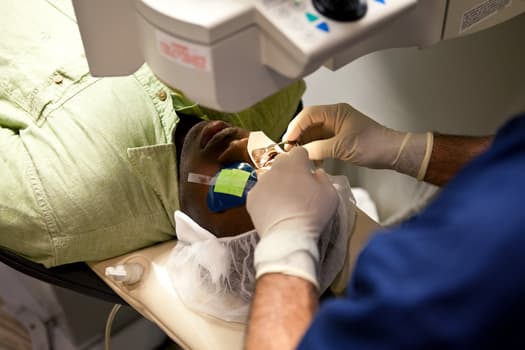The agency’s recommendations should balance risk with benefit

LASIK surgery has been studied continuously since the FDA approved the procedure nearly a quarter century ago. These studies include careful documentation of the success rates in improving vision without the need for glasses, as well as the risks for complications. This information has long been included in the labelling for the devices used in LASIK. Yet, the FDA recently decided to propose new documents revising the description of risks and benefits.
We, at the American Academy of Ophthalmology (AAO), share the goals of the FDA: to protect patient safety, and to help patients make an informed choice, meaning a choice based on complete information that includes not just risks and benefits, but a good sense of the likelihood of these outcomes. However, the FDA has produced a statementopens in a new tab or window that focuses so heavily on risks that it makes it difficult for patients to accurately assess the appropriateness of LASIK for their situation.
The efficacy of LASIK is well supported by numerous studies. A reviewopens in a new tab or window of nearly 100 research articles representing nearly 70,000 eyes has reported that more than 90% of eyes undergoing LASIK had 20/20 or better vision without glasses, and more than 99% driving vision of 20/40 or better. The U.S. military has also generated a great deal of useful information and has trusted refractive surgery to improve the vision of active servicemen and women for many years, becoming one of the largest providers of refractive surgery in the country. Rigorous studies performed by the military have described the safety and effectivenessopens in a new tab or window of LASIK in terms of night visionopens in a new tab or window, night drivingopens in a new tab or window, flight performanceopens in a new tab or window, and firing performanceopens in a new tab or window.
The FDA’s own well-conducted PROWL studyopens in a new tab or window on outcomes following LASIK found high rates of patient reported satisfaction: While most participants were satisfied, the rates of dissatisfaction with vision ranged from 1% to 4%, and the rates of dissatisfaction with surgery ranged from 1% to 2%.
As successful as refractive surgery is, it is not for everyone. Some patients have eye conditions or anatomy that are not well suited to laser treatment. Even when appropriate, no surgical intervention can be risk-free. The discussion that educates patients on whether surgery is right for them, along with the benefits and risks of LASIK based upon their unique profile and needs is a critical element of the decision-making process. AAO’s Code of Ethics dictates that it is the physician performing the procedure who is responsible for educating the patient and obtaining meaningful informed consent.
The topics covered in the guidance document — the risks for problems such as double vision, dry eyes, difficulty driving at night, and, in rare cases, persistent eye pain — are all important for the informed consent process, but they must be presented with sufficient depth and nuance for the patient to better understand what these data mean for them. We believe that effective informed consent is not merely a listing of potential poor outcomes that one must know about, but a process of shared information and decision-making that happens interactively between the physician and the patient, where both come to thoroughly understand the patient’s situation, goals, and motivations.
Beyond the ethical imperative, AAO believes that an informed patient, whether they choose to undergo surgery or not, is a more satisfied patient. This is why we have generated extensive educational resources for both ophthalmologists and their patients, including a patient guide to refractive surgeryopens in a new tab or window, which we produced in partnership with the FDA. AAO-affiliated Ophthalmic Mutual Insurance Company provides a comprehensive informed consent form in both English and Spanish that is widely used by physicians and their patients. Additionally, AAO’s EyeSmart program offers evidence-based and commercially unbiased information about eye health, including vision correction surgeriesopens in a new tab or window such as LASIK. And we offer guidelinesopens in a new tab or window to assist ophthalmology practices in providing ethical, informative advertising for refractive surgery.
Beyond the issues of balance, nuance, and personalization, we are also concerned that the proposed update to patient guidance on LASIK surgery provides information that does not reflect the most current clinical evidence. For example, the suggested guidance lists pupil size as a risk factor for complications. The issue of pupil size has been studied extensively over the years. Data from published studiesopens in a new tab or window of modern lasers fail to demonstrate a relationship between pupil size and the quality of postoperative vision. And yet, FDA lists pupil size as a risk factor for poor vision after LASIK surgery.
The FDA’s proposal is not final. More than 600 individuals and professional groups have weighed in with comments since the draft of the guidance was made public in July, and the agency is now reviewing the input while preparing the final documents. Many comments reflect these concerns, and we hope that the FDA will consider them seriously.
AAO has a long and productive relationship with the FDA. We look forward to continuing our collaboration to ensure that our common goal is met: to educate the public about LASIK and its outcomes with an evidence-based and balanced approach.



